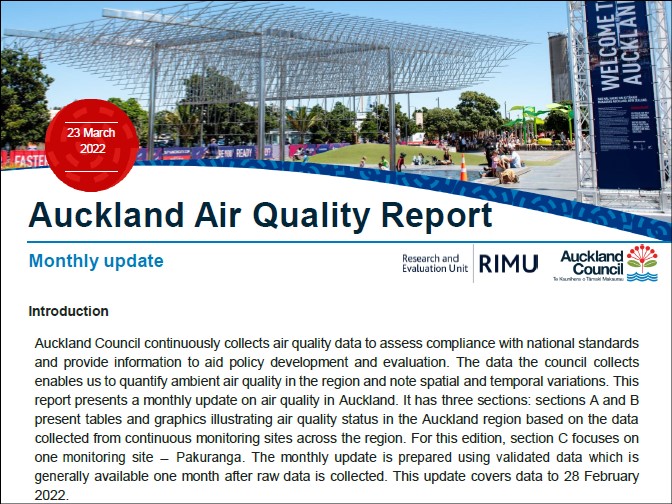Auckland air quality report November 2022
Author:
Louis Boamponsem, Auckland Council Research and Evaluation Unit, RIMUSource:
Auckland Council Research and Evaluation Unit, RIMUPublication date:
2022Topics:
EnvironmentExtract:
Introduction
Auckland Council continuously collects air quality data to assess compliance with national standards and provide information to aid policy development and evaluation. The data the council collects enables us to quantify ambient air quality in the region and note spatial and temporal variations. This report presents a monthly update on air quality in Auckland. It has four sections: sections A and B present tables and graphics illustrating air quality status in the Auckland region based on the data collected from continuous monitoring sites across the region. For this edition, section C focuses on one monitoring site ̶ Glen Eden. Section D provides the monthly averages for 2022 and the past two to five years pollutant concentrations (when data is available). The monthly update is prepared using validated data which is generally available one month after raw data is collected. This update covers data to September 2022.
Summary
- In September, there was no exceedance of the National Environmental Standard for Air Quality (NESAQ).
- Apart from the city centre sites, all the air quality monitoring sites recorded average NO2 concentrations higher than the same period of the previous year (January to September).
- As expected, the highest NO2 concentrations were measured at the city centre sites, although the concentrations are lower than the same period of the previous year. Auckland transport traffic volume data collected between 15-21 August 2022, shows that 24 hour traffic volume at the city centre monitored intersections are between 70% to 80% relative to normal (pre-covid levels).
- Most monitoring sites recorded particulate matter (PM10 and PM2.5) concentrations higher than the same period of the previous year (January to September). The higher PM levels in the city centre sites is most likely due to the dust generated by the ongoing construction, and roadworks projects.
- Compared to the same period of the previous year, there has been a 23% decrease in carbon monoxide (CO) average concentration measured at the Khyber Pass Road monitoring site. This is most likely due to a 4% reduction in traffic in that area.
- Air quality of a monitoring site can vary from year to year due to weather and other influences and for trend analysis of change see Table 2 and this report: Auckland Air quality report October 2021
Read the frequently asked questions about the air quality monitoring in the Auckland region.
For more information or questions, please send inquiries to: environmentaldata@aucklandcouncil.govt.nz
Auckland Council, November 2022
Previous reports
